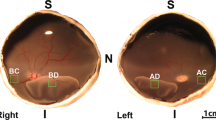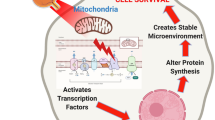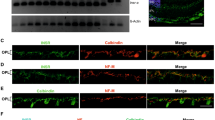Abstract
The antibiotic tunicamycin inhibits the biosynthesis of N-acetyl-glucosaminylpyrophosphoryl polyisoprenol1–3, a key intermediate in the formation of the asparagine-linked oligosaccharides of glycoproteins4. The effects of tunicamycin have been studied in various biological systems5, primarily with the aim of elucidating the role of the carbohydrate moieties in the cellular function of glycoproteins6. Rhodopsin, the visual pigment of retinal rod photoreceptor cells, is a membrane glycoprotein which consists of a single polypeptide chain (opsin) to which a chromophoric prosthetic group (II-cis-retinaldehyde) and two asparagine-linked oligosaccharide chains are covalently attached7. The glycosylation of opsin can be blocked with tunicamycin in vitro in conditions where polypeptide synthesis is only slightly decreased8,9. We have reported9 that tunicamycin can disrupt the normal assembly of rod outer segment membranes in vitro without significantly inhibiting the biosynthesis or intracellular transport of opsin. Here we report that intraocular injection of tunicamycin produces a photoreceptor-specific degeneration characterized by (1) progressive shortening of rod outer segment, (2) decreased electroretinogram amplitudes, (3) cessation of rod outer segment membrane assembly, and (4) eventual photoreceptor cell death.
This is a preview of subscription content, access via your institution
Access options
Subscribe to this journal
Receive 51 print issues and online access
$199.00 per year
only $3.90 per issue
Buy this article
- Purchase on Springer Link
- Instant access to full article PDF
Prices may be subject to local taxes which are calculated during checkout
Similar content being viewed by others
References
Takatsuki, A., Kohno, K. & Tamura, G. Agric. biol. Chem. 39, 2089–2091 (1975).
Tkacz, J. S. & Lampen, J. O. Biochem. biophys. Res. Commun. 65, 248–257 (1975).
Lehle, L. & Tanner, W. FEBS Lett. 71, 167–170 (1976).
Struck, D. K. & Lennarz, W. J. in The Biosynthesis of Glycoproteins and Proteoglycans (ed. Lennaz, W. J.) 35–83 (Plenum, New York, 1980).
Tamura, G. (ed.) Tunicamycin (Japan Scientific Societies, Tokyo, 1982).
Olden, K., Parent, J. B. & White, S. Biochim. biophys. Acta 650, 209–232 (1982).
Hargrave, P. A. in Progress in Retinal Research Vol. 1 (eds Osborne, N. & Chader, G.) 1–51 (Pergamon, New York, 1982).
Plantner, J. J., Poncz, L. & Kean, E. L. Archs Biochem. Biophys. 201, 527–532 (1980).
Fliesler, S. J., Rayborn, M. E. & Hollyfield, J. G. J. Cell Biol. 97, 413a (1983).
Rapp, L. M. & Basinger, S. F. Vision Res. 22, 1097–1103 (1982).
Hollyfield, J. G., Rayborn, M. E., Sarthy, P. V. & Lam, D. M. K. J. comp. Neurol. 188, 587–598 (1979).
Young, R. W. Invest. Ophthalmol. vis. Sci. 15, 700–725 (1976).
Graymore, C. N. in Biochemistry of the Eye (ed. Graymore, C. N.) 645–735 (Academic, New York, 1970).
Yamada, K. M. & Olden, K. in Tunicamycin (ed. Tamura, G.) 119–144 (Japan Scientific Societies, Tokyo, 1982).
Fliesler, S. J., Tabor, G. A. & Hollyfield, J. G. Expl Eye Res. (in the press).
Kolb, H. & Gouras, P. Invest. Ophthalmol. vis. Sci. 13, 487–498 (1974).
Szamier, R. B. & Berson, E. L. Invest. Ophthalmol. vis. Sci. 16, 947–962 (1977).
Szamier, R. B., Berson, E. L., Klein, R. S. & Meyers, S. Invest. Ophthalmol. vis. Sci. 18, 145–160 (1979).
Rayborn, M. E., Moorhead, L. C. & Hollyfield, J. G. Opthalmology 89, 1441–1454 (1982).
Bunt-Milam, A. H., Kalina, R. E. & Pagon, R. A. Invest. Ophthalmol. vis. Sci. 24, 458–469 (1983).
Hollyfield, J. G., Frederick, J. M., Tabor, G. A. & Ulshafer, R. J. Ophthalmology 91, 191–196 (1984).
Author information
Authors and Affiliations
Rights and permissions
About this article
Cite this article
Fliesler, S., Rapp, L. & Hollyfield, J. Photoreceptor-specific degeneration caused by tunicamycin. Nature 311, 575–577 (1984). https://doi.org/10.1038/311575a0
Received:
Accepted:
Issue Date:
DOI: https://doi.org/10.1038/311575a0
This article is cited by
-
Regulation of dolichol-linked glycosylation
Glycoconjugate Journal (2013)
-
ADrosophilametallophosphoesterase mediates deglycosylation of rhodopsin
The EMBO Journal (2011)
-
Transport of phosphatidylcholine toXenopus photoreceptor rod outer segments in the presence of tunicamycin
Journal of Neurocytology (1994)
-
Tunicamycin does not inhibit transport of phosphatidylinositol toXenopus rod outer segments
Journal of Neurocytology (1993)
Comments
By submitting a comment you agree to abide by our Terms and Community Guidelines. If you find something abusive or that does not comply with our terms or guidelines please flag it as inappropriate.



